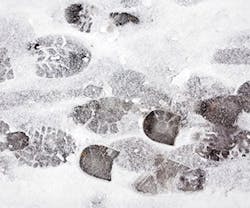That bucket of blue-tinged rock salt is a familiar weapon against Old Man Winter, but the environmental drawbacks of sodium chloride will be noticeable in the spring. From killing plants to harming wildlife, traditional deicers are nothing but bad news for the environment. There are a number of safer but equally effective options that will tackle ice and sleet lingering on your property.
The Disadvantages of Rock Salt
Rock salt (sodium chloride) is great for making ice cream, but think twice about spreading it on your sidewalks. The resulting brine can choke out vegetation and increase the salinity of water so it’s unfit for animals to drink or live in. This can create ongoing costs if you have to replace damaged landscaping and grass each year.
“Some deicers can also corrode some exterior surfaces of buildings, especially steel, and can deteriorate concrete if it has not been properly sealed,” notes Stephen Ashkin, Founder of the Green Cleaning Network and President of the consulting firm The Ashkin Group. “While it is clear that traditional deicers contain powerful ingredients that help promote safety, they also cause significant damage to properties and the environment.”
It’s understandable that facility managers continue to use rock salt when it’s familiar, has a proven track record and costs are low, concedes Ashkin. And given all of your numerous responsibilities, snow removal expenses are probably at the bottom of your priority list. But if your organization is pursuing sustainability, this is an obvious opportunity to make a better choice.
“Understand that the purpose of rock salt isn’t to melt snow and ice – it’s supposed to be applied before a snow event so it’s easier to remove accumulation,” Ashkin clarifies.
The basic chemistry of sodium chloride means that the compound dissolves in moisture and the resulting brine has a lower freezing point than water. Most users also overlook the fact that rock salt only works in temperatures no lower than 15-20 degrees F. The offices of BUILDINGS, located in the Midwest, know a thing or two about the joys of negative wind chills.
Alternatives to Rock Salt
- Uses magnesium, calcium, or potassium chloride or calcium magnesium acetate
- Is either non-corrosive or includes a corrosion inhibitor
- Works in temperatures below 15 degrees F.
- Uses naturally sourced tints or dyes
- Pet friendly (won’t irritate animal paws)
- Derived from plant sugars, such as corn, sugar cane or beets
- Organic-based additives are biodegradable
- Available as a liquid form for better adherence
- Requires less volume to achieve the same effectiveness as salt
There is also a great temptation to spread salt with a liberal hand, which is wasteful of the material and your budget.
“No matter how inexpensive rock salt is, if you’re using two, three or five times the amount necessary, you’re fundamentally changing the cost equation as well as increasing the environmental impact,” Ashkin stresses.
A Better Choice
Replace sodium with other chloride compounds, such as calcium, magnesium or potassium chloride. There are a number of acetates that work similarly as well, such as calcium magnesium or potassium acetate. You may even choose a blend with urea, which is commonly used as a nitrogen fertilizer but also has melting properties.
Many of these mixes may also be augmented with organic deicers, often derived from beet, cane or corn sugars. Some intrepid states have turned to cheese brine, pickle juice or fermented brewery byproducts for roadways.
Keep in mind that while all of these options have fewer drawbacks, they aren’t without tradeoffs. It would be a mistake to think of them as a free environmental pass.
“These alternative deicers are very effective, but at the end of the day, they’re still based on salt,” cautions Brandon Rux, Manager of Landscaping and Grounds at the University of Chicago. “You still need to regulate how much you have to put down. The material might get into the water stream and harm plants.”
“Another option that may work in some situations is to use options such as gravel, wood chips or straw on key walkways,” Ashkin says. “These are all alternatives to salt that when applied properly can help ensure walker safety. Plus, they have little or no impact on the environment.”
One thing to anticipate is the higher price – it’s one of the few times switching to a green product will increase your expenditures because rock salt has a significantly lower cost. Perform a basic analysis of your current deicer usage and costs so you can accurately project the impacts of switching. Some organizations, like the University of Chicago, have found that they are more comfortable with the cost of alternative deicers if they limit them to certain applications, such as sidewalks and entryways rather than parking lots and streets.
You may also frame this swap as a way to avoid costs. If you’re constantly having to replace wilted landscaping, fix interior floors that have been damaged or test your property’s stormwater runoff, this can reinforce the savings aspect. If all else fails, evoke your company’s green mission statement – organic and non-corrosive deicers are an easy and no-fuss way to reach sustainability goals.
Jennie Morton [email protected] is Senior Editor of BUILDINGS.
About the Author
Jennie Morton
A former BUILDINGS editor, Jennie Morton is a freelance writer specializing in commercial architecture, IoT and proptech.
